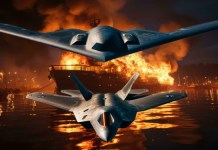As the Russia-Ukraine war rages on and former F-16 pilot taking a dig at Su-35 jets, the US Air Force’s F-16 Fighting Falcons stationed in South Korea have begun receiving critical upgrades to their radar and avionics systems to improve their operational capabilities.
The USAF has announced that an upgraded Fighting Falcon, Wolf Pack Tail 021, has rejoined the 8th Fighter Wing’s Pack on April 4 after undergoing the first phase of one of the most extensive modernization projects in the history of the US Air Force’s F-16 program.
The 8th Fighter Wing of the United States Air Force is the primary unit stationed at Kunsan Air Base, located in the Republic of Korea, and falls under the jurisdiction of the Seventh Air Force.
The F-16s are getting these enhancements as a part of the Post Block Integration Team project. The project’s objective is to enhance the lethality and survivability of F-16s to satisfy the requirements of both present and upcoming missions.
The key elements of the upgrade comprise the APG-83 Scalable Agile Beam Radar (SABR) with an Active Electronically Scanned Array (AESA) and the Center Display Unit (CDU).
The upgrades will offer pilots a more precise view of the dangers surrounding them, thereby augmenting the weapon system’s survivability and accuracy, the USAF said.
Col. John D. Caldwell, the Vice Commander of the 8th Fighter Wing, said given that the F-16 is expected to remain operational until the 2040s, this upgrade is imperative to ensure that the USAF stays up-to-date with the developing threat environment.
WP Tail 021 has become the first F-16 aircraft belonging to the 7th Air Force that resumes flying operations with PoBIT upgrades.
The rest of the fleet will also receive these upgrades, which will enhance the USAF’s capacity to secure a free and open Indo-Pacific area and maintain stability in the Korean Peninsula, the service added.
“The avionics upgrades allow pilots to take full advantage of the jet’s advanced weapons and sensors. It can provide high-speed data and/or high-resolution video and ultimately aids the pilot in tactical decision-making,” said Capt. Michael C. Durham, 8th Operations Support Squadron, Weapons Tactics Officer.
With the radar upgrade, the F-16 can now track a larger number of targets from longer distances, even in challenging conditions where cooperation may not be present.
The enhancement improves the aircraft’s all-weather abilities by integrating synthetic aperture radar mapping for better target identification and engagement.
Ex-F-16 US Pilot Explains The Tactics Of The Russian Air Force
The F-16s have been in the headlines recently because Ukraine has asked the US and its allies for these aircraft so that they can defend their skies against Russian attacks.
Ukrainian officials have asserted that their outdated fighter jets from the Soviet era are insufficient to confront the significantly more advanced Russian fighter jets, especially the Su-35.
On the other hand, the Russian government routinely claims that Western fighter jets can’t compete with its advanced warplanes.
However, Retired Lieutenant Colonel Dan Hampton, also known by his call sign Two Dogs, who is considered the “deadliest F-16 pilot” of the US Air Force, believes that the Russian military has misconceptions about modern air warfare.
He believes that if Russia tries to catch up with the F-16, they will inevitably face defeat. In his conversation with The Facts, Hampton elaborated that there are two types of air combat: one is fought at long ranges using sensors and radar, while the other is fought at close ranges.

He added that the radar technology used in Su-35 is outdated and was developed 30 years ago. In contrast, the F-16’s radar is more sophisticated and provides pilots with better opportunities to engage targets at longer distances.
Additionally, the F-16’s radar allows pilots to track multiple targets and engage them with multiple missiles, depending on the number of missiles available.
Regarding close combat, Hampton mentioned that the F-16 has an advantage due to its compact size and streamlined design, making it less visible than other fighters, such as the MiG-29.
Furthermore, he added that the F-16’s high maneuverability gives it an edge during dogfights. Hampton observed that air combat tactics play a crucial role in such conflicts.
The pilot recollected that based on his understanding of the aerial battles in Ukraine, the Russians employ identical tactics in the air as they do on the ground. He mentioned that they rely on numerical superiority rather than exhibiting the ingenuity demonstrated by Ukrainian pilots.
He had also previously trained with the Russian pilots. Hampton also makes the following conclusions: “Russian pilots went straight up and thought this would entail some problems with our radars – and we will not see them. But we just shot them in the stomach every time. We were just smiling and shooting at them.”
Hampton recently said he would fight for Ukraine if the US and Ukraine governments allowed private military contractors. Furthermore, Hampton has previously criticized Russian fighters, labeling them “junk” that should only be shown at air shows.
- Contact the author at ashishmichel(at)gmail.com
- Follow EurAsian Times on Google News





